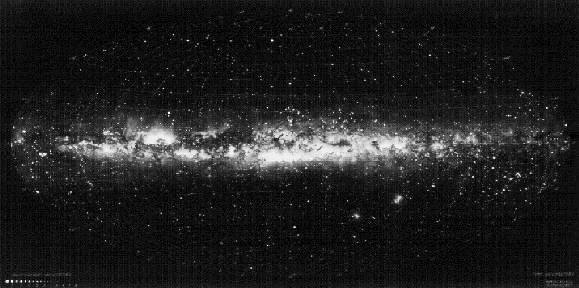What is a Galaxy?
A Galaxy is huge formation of star-systems that together form a cluster that rotates about a common center of mass.
Compare this to a solar system. A solar system can be a collection of planets orbiting it's host star, a Galaxy is a
collection of solar systems that orbit a common center of mass.
History
Before the arrival of the telescope (around 1600 AD), astronomers were rather limited in their observational possibilities of the night sky.
Once Galileo made his significant discoveries using a telescope, other people followed in his footsteps. This meant that telescopes quickly
became better and better. Perhaps the first attempt to compile a catalogue of stars was made by the famous Greek astronomer Hipparchus over 2100
years ago. The first modern attempt to make a chart of the stars using telescope aided observations was made by Johan Hevel (Hevelius from Dantzig)
although, his catalog of 1564 stars was published after his death (1687). John Flamsteed was another star-charting pioneer. In 1712 he published
a catalogue of 3000 stars (Historia Coelestis Britannica, revised in 1725).
(First documented observation of a real galaxy was the observation of the Andromeda galaxy by Persian astronomer Al Sufi in 964 AD.)
It was William Herschel who first described the shape of the Milky Galaxy towards the end of the 18:th century but at that point, it still wasn't
known that there were other galaxies outside the Milky Way.
While astronomers were too busy measuring what they could see, it was in fact a philosopher that first speculated about the existence of other galaxies
outside the Milky Way (although, at the time they referred to the 'cloudy objects' in the sky, the s.c. Nebulae). The name of this philosopher was
Immanuel Kant and he made his proposal in 1755.
As it turned out, it would take far more powerful telescopes and the persistence of Edwin Hubble to finally prove that these Nebulae indeed lie outside
the Milky Way. This final proof came in 1923. Since then, our knowledge about the universe has increased vastly thanks to the large amount of powerful telescopes
not the least the space telescope that was named after Edwin Hubble. It is now known that the Milky Way is only one of billions upon billions of other galaxies.
in fact, the Milky Way is just as unremarkable in relation to the rest of the Universe as our Sun is unremarkable in relation to the other 200 billion stars in our Galaxy.
The Milky Way
Our Galaxy is called the Milky Way. (From the greek 'Galactos' which means more or less 'milk', referring to
ths bright stripe in the night sky that can be seen in areas that don't suffer from light pollution.)
Milky Way is a spiral galaxy that consists of about 200 billion (200,000,000,000) stars (It is not known exactly how many
stars there are in our Galaxy, but the lower and upper limits are probably 100 billion and 400 billion respectively).
Our sun is only one of those 200 billion stars. For obvious reasons, we can't take a picture of our galaxy from
outside.
Beelow is a mosaic of photos assembled to show how the galaxy looks like in profile. [Image produced by Lund university, Sweden]

To get an idea how the Milky Way looks from other angles, astronomers usually show other galaxies which they think
look a lot like our own. A popular choice is the spiral galaxy NGC 2997. It is thought that this is a fair representation
of how Milky Way looks like.

[The spiral galaxy, NGC 2997]
Each of those stars may or may not have it's own planetary system. Many of them have, but many
systems consist of several stars orbiting each other. A star we see here from Earth may in fact be a system of several stars.
The star Capella, clearly visible in the night sky (constellation Auriga) is actually a 10-star system dominated by
two Yellow Giants and 8 smaller stars.
Milky Way, Technical Data
| Name of our Galaxy: |
Milky Way |
| Type of galaxy |
Spiral, with 4 major 'arms' (number of arms is not 100% certain) |
| Radius |
~50,000 lightyears (i.e. 100,000 ly across) |
| Rotational Period (at Sun's location) |
About 226 Million years (Also known as a Galactic Year) |
| Sun's distance from galactic center |
~27,700 lightyears |
|

